
The Solar-Terrestrial Centre of Excellence (STCE) is a collaborative network of the Belgian Institute for Space Aeronomy, the Royal Observatory of Belgium and the Royal Meteorological Institute of Belgium.
 |
Published by the STCE - this issue : 28 May 2014. The Solar-Terrestrial Centre of Excellence (STCE) is a collaborative network of the Belgian Institute for Space Aeronomy, the Royal Observatory of Belgium and the Royal Meteorological Institute of Belgium. |
| Archive of the newsletters | Subscribe to this newsletter by mail |
We invite you for an 2014 STCE update presented on June 12. We compiled a morning filling program with enthusiastic speakers and activities.
Ronald Van der Linden opens the meeting at 10h after an optional caffeine shot,
Going smoothly to our guest speaker from the British Geological Survey (BGS): Alan Thompson.
Followed by an outline of 5 workshops by Nicolas Bergeot, Cis Verbeeck, Els Janssen, Michael Pieters and Pepijn Cardoen:
* Modelling of antennas and calibration of radio instruments, June 6, 2014 - still to come!!
* Physical Processes in Solar-Terrestrial Plasmas, 20, 22 and 23 May, 2014
* Long term solar changes, May 19, 2014
* Tomography and 3D reconstruction, April 7, 2014
* Science and science operations of the PROBA satellite fleet, March 31, 2014
After a break with caffeine and/or vitamins, you will meet Julie Berckmans, Antonio Martinez, Dan Ryan and again Pepijn during a guided tour through the mysteries of LYRA, Radio science fiction, GNSS investigations of the troposphere and the Picasso space technology.
We conclude with lunch.
The annual meeting will take place in the buildings - Meridian Room - of the Space Pole, Ringlaan 3, 1180 Brussels, Belgium.
program: http://www.stce.be/annualmeeting/annualmeeting2014.php
Registration is free, easy and 1 click away: http://tinyurl.com/pjyc9dj - deadline Tuesday June 10, no need to wait that long.
We hope to welcome you at our yearly STCE event!
Solar flare activity was low this week, except on Saturday when an M1.3 flare occurred.
In order to view the activity of this week in more detail, we suggest going to the following website from which all the daily (normal and difference) movies can be accessed: http://proba2.oma.be/ssa.
This page also lists the recorded flaring events.
A weekly overview movie can be found here: http://proba2.oma.be/swap/data/mpg/movies/WeeklyReportMovies/WR217_May19_May25/weekly_movie_2014_05_19.mp4 (SWAP week 217).
Details about some of this week’s events can be found further below.
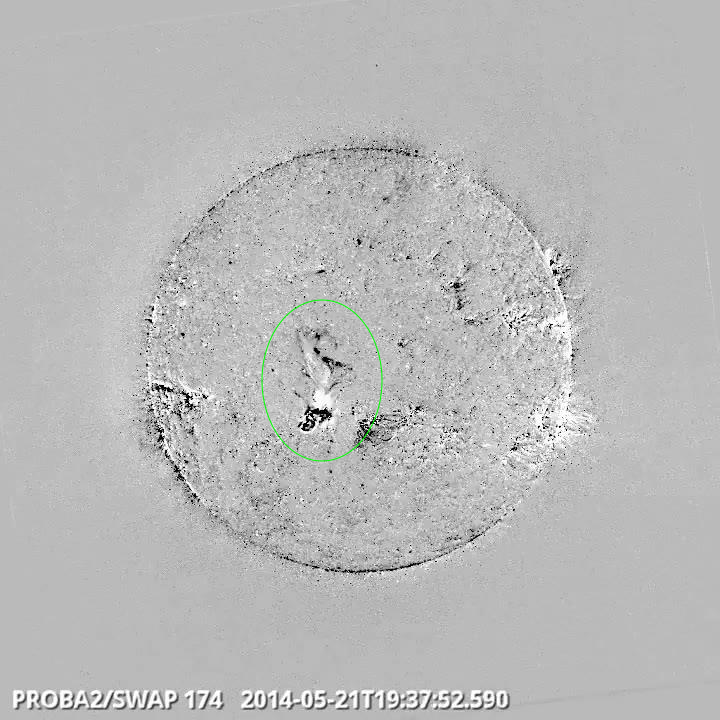
Eruption on-disk, Center, between North and South @ 19:37 - SWAP difference image
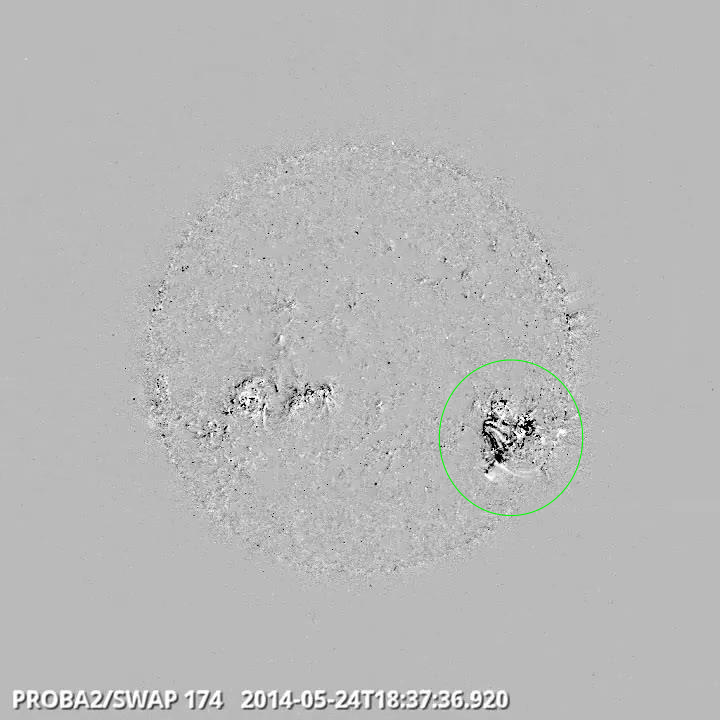
M1.3 flare in South West Quadrant @ 18:37 - SWAP difference image
Solar activity was mostly at C level during the week of May 19 to 25, 2014. In total, one M flare and 23 C flares were observed. There was some sporadic C flaring from NOAA regions 2066, 2071, 2072, 2073, and 2068 in the first half of the week. In the second half of the week, AR 2068 released almost all C flares and the M1.3 flare of May 24.
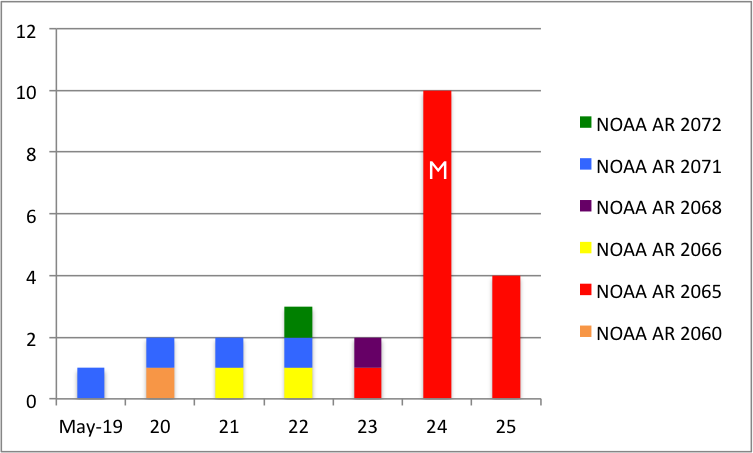
Solar wind speed as observed by ACE was low (between 300 and 350 km/s) until the arrival of a high speed stream from a southerly coronal hole.
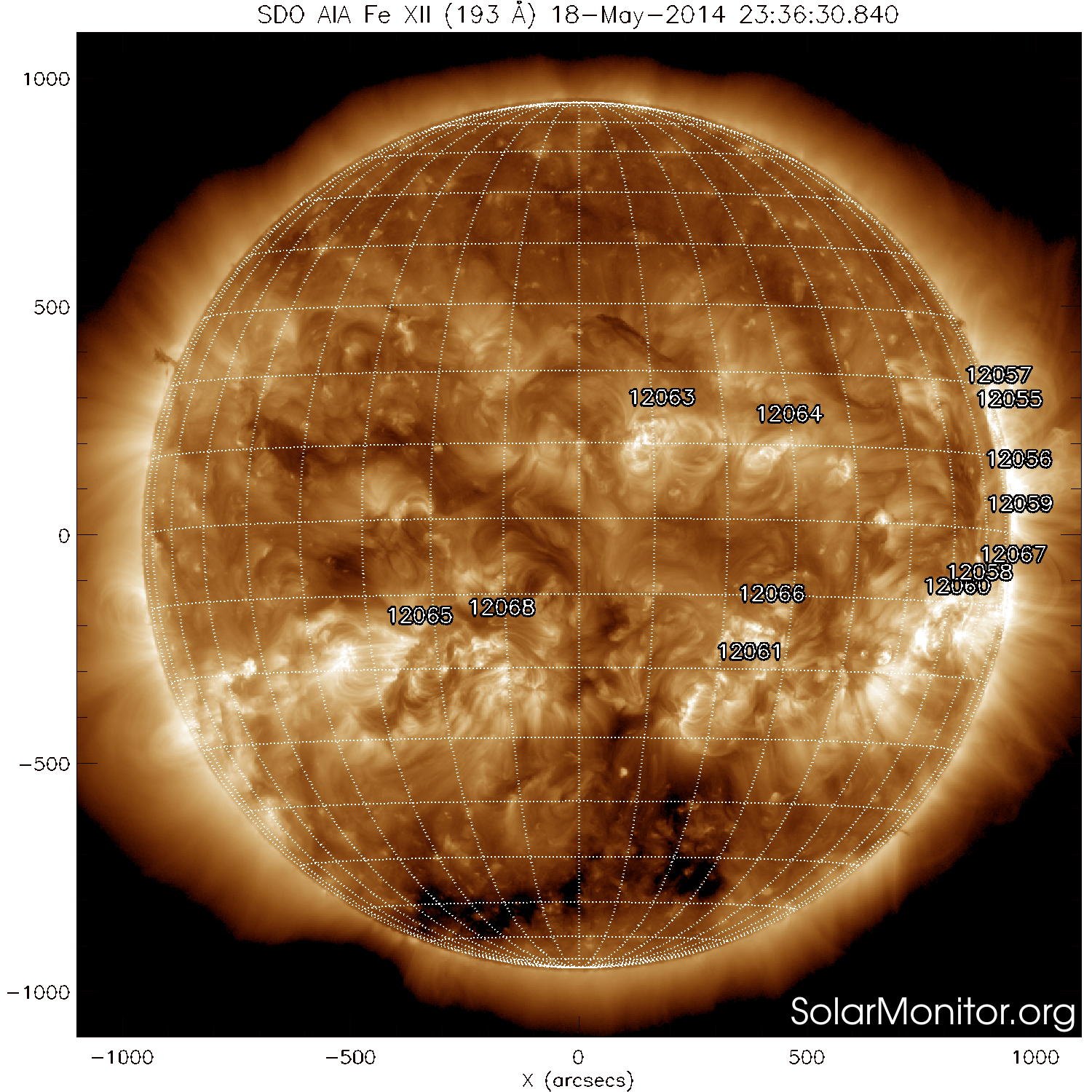
The co-rotating interaction region arrived on May 22. The solar wind speed increased up to about 500 km/s on May 23, causing a minor geomagnetic storm in the late UT hours of that day. Geomagnetic activity has been quiet (K Dourbes and NOAA Kp less than 4) throughout the rest of the week. The solar wind speed had decreased to about 400 km/s at the end of May 25.
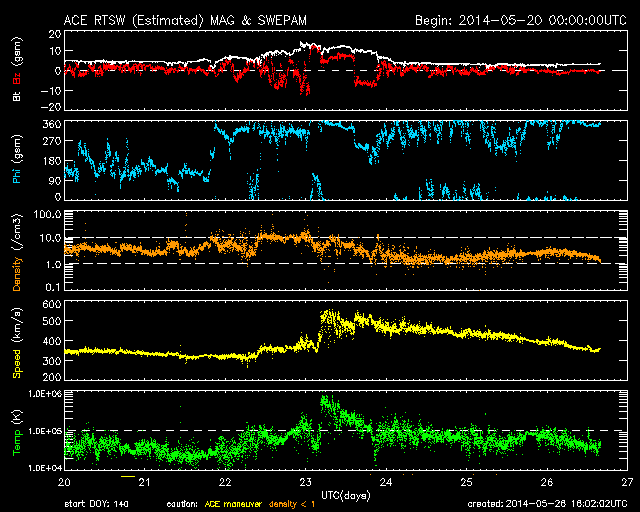
| DAY | BEGIN | MAX | END | LOC | XRAY | OP | 10CM | TYPE | Cat | NOAA |
| 24 | 1826 | 1835 | 1844 | M1.3 | 229 | 53 | 2065 |
| LOC: approximate heliographic location | TYPE: radio burst type |
| XRAY: X-ray flare class | Cat: Catania sunspot group number |
| OP: optical flare class | NOAA: NOAA active region number |
| 10CM: peak 10 cm radio flux |
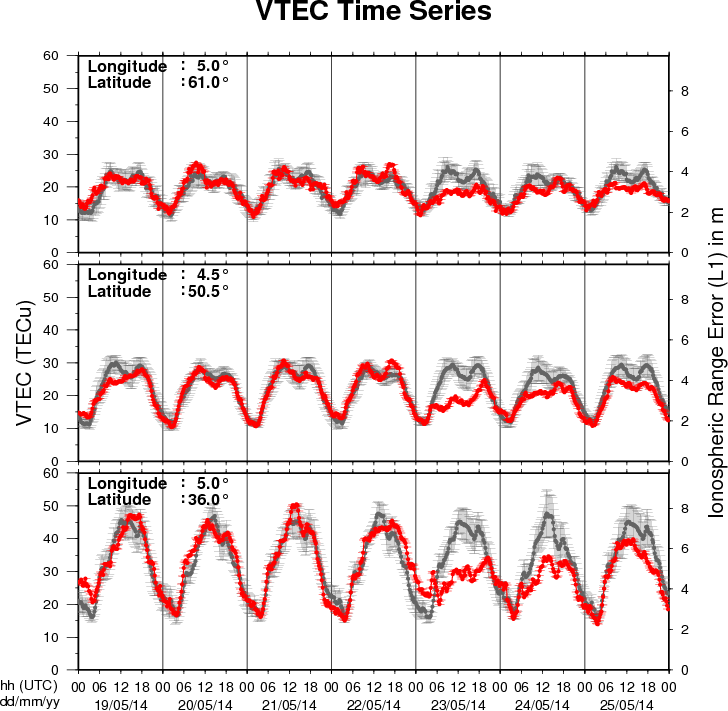
The figure shows the time evolution of the Vertical Total Electron Content (VTEC) (in red) during the last week at three locations:
a) in the northern part of Europe(N61°, 5°E)
b) above Brussels(N50.5°, 4.5°E)
c) in the southern part of Europe(N36°, 5°E)
This figure also shows (in grey) the normal ionospheric behaviour expected based on the median VTEC from the 15 previous days.
The VTEC is expressed in TECu (with TECu=10^16 electrons per square meter) and is directly related to the signal propagation delay due to the ionosphere (in figure: delay on GPS L1 frequency).
The Sun's radiation ionizes the Earth's upper atmosphere, the ionosphere, located from about 60km to 1000km above the Earth's surface.The ionization process in the ionosphere produces ions and free electrons. These electrons perturb the propagation of the GNSS (Global Navigation Satellite System) signals by inducing a so-called ionospheric delay.
See http://stce.be/newsletter/GNSS_final.pdf for some more explanations ; for detailed information, see http://gnss.be/ionosphere_tutorial.php
Start : 2014-06-10 - End : 2014-06-11
The STCE workshop 'Inter-Calibration and Degradation of EUV
Instruments' aims at understanding the differences observed between
the various instruments observing in the SXR-EUV range and at
analyzing the ageing effects that affect their results. It targets
imagers as well as spectrometers and photometers.
The workshop will be followed by two days of working sessions
(June 12-13) organized by the Solar EUV Irradiance Working Group
(also supported by the STCE). These working sessions are in the
continuity of similar events organized in 2011, 2012 and 2013, but
they are open to new participants and you are welcome to join if
you are interested.
Website:
http://www.stce.be/euvworkshop2014/
Start : 2014-06-19 - End : 2014-06-20
During the summer of 2014 DTU Space will host the 3rd Swarm
Science Meeting, sponsored by the European Space Agency, ESA
. This meeting will take place at
the IDA Conference Centre in Copenhagen on June 19th to 20th 2014
and is open to the science community at large.
Website:
http://congrexprojects.com/2014-events/Swarm/home
Presentation given at the STCE Workshop Tomography and 3D reconstruction in space science, April 2014 on 3D CME reconstruction: constraints, methods and an application.
http://www.spaceweather.eu/en/repository/show?id=516
Presentation given at the workshop Tomography and 3D reconstruction in space science, April 2014 on temperature and density reconstruction of coronal structures. The technique which is based on Python is applied to polar plumes observed in SDO/AIA images.
http://www.spaceweather.eu/en/repository/show?id=517
Presentation given at the workshop Tomography and 3D reconstruction in space science, April 2014 about the work performed at Vision Lab ASTRA: All Scale Tomographic Reconstruction Antwerp.
http://www.spaceweather.eu/en/repository/show?id=518
Presentation given at the workshop Tomography and 3D reconstruction in space science, April 2014 on how the 2D energy spectra of electron above the auroral arcs are estimated. The technique uses optical ground-based observations done with ALIS, Auroral Large imaging System.
http://www.spaceweather.eu/en/repository/show?id=519
Raising awareness and get people outside the scientific community involved in space weather becomes more and more an issue. To cross the borders of our science project eHEROES, we came up with a tide communication plan that answers the questions: what, to whom, why, when, how, by whom? The key is to link the audience and your message in a correct way. Both formal and informal education are on our tool list.
This is an invited poster presented at EGU, 2014 in the session
Raising and maintaining awareness of our local space weather: education and public outreach.
eHEROES, Environment for Human Exploration and RObotic Experimentation in Space is an FP7 project (n° 284461, www.eheroes.eu).
http://www.spaceweather.eu/en/repository/show?id=520
Presentation given at the STCE workshop Long Term Solar changes about the variation of the TSI measured from space by past and present missions, e.g. Diarad/Sovim. These data are used to reconstruct the TSI up to 400 years ago.
http://www.spaceweather.eu/en/repository/show?id=521
Presentation given at the STCE workshop Long Term Solar Changes about the revision of the efficiency correction factor used for Sova-P TSI data series.
http://www.spaceweather.eu/en/repository/show?id=522
Presentation given at the STCE workshop Long Term Solar changes about Solar Solspec on board of the ISS.
http://www.spaceweather.eu/en/repository/show?id=523
Presentation given at the STCE workshop Long Term Solar changes on the influence of long term solar changes on parameters describing the earth magnetosphere, cosmic rays and the ionosphere.
http://www.spaceweather.eu/en/repository/show?id=524
Presentation given at the STCE workshop Long Term Solar changes about the radiation recorded by the Bolometric Oscillation sensor aboard the PICARD micro satellite.
http://www.spaceweather.eu/en/repository/show?id=525